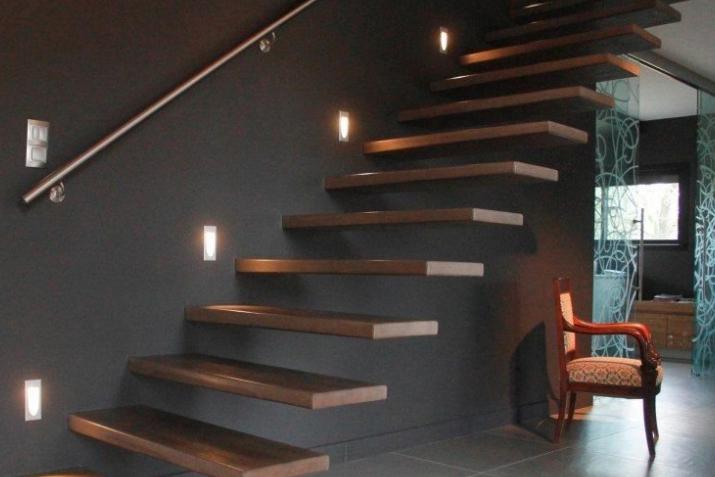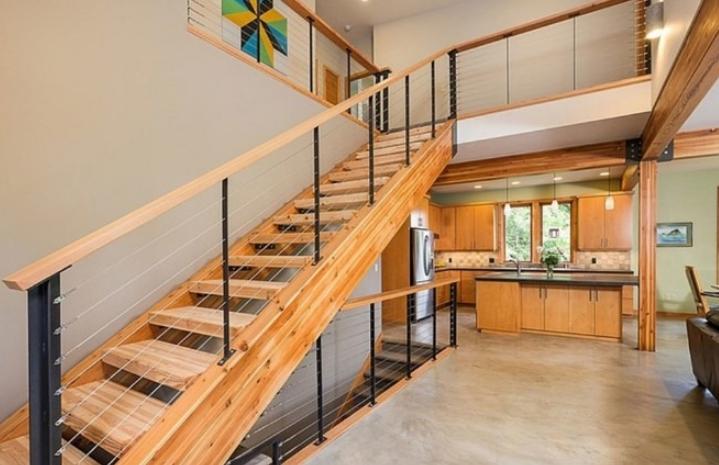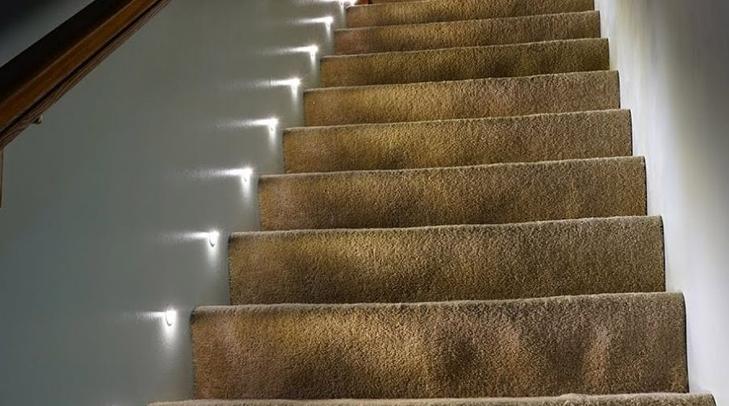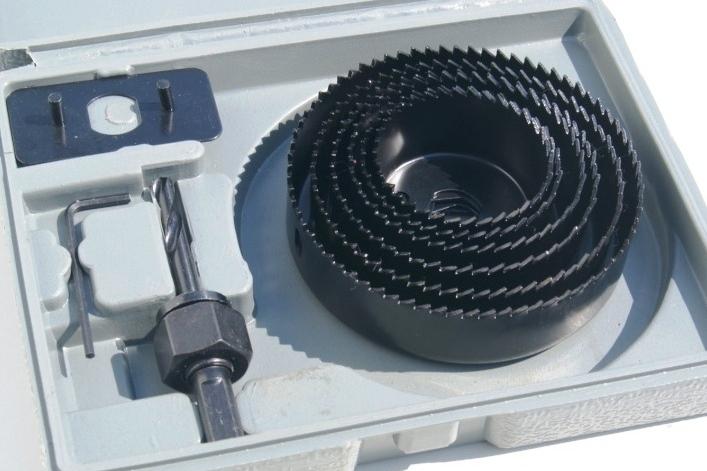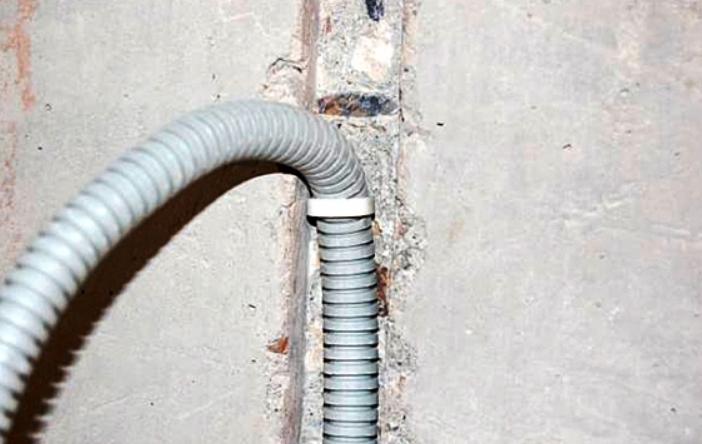Staircase lighting in a private home
Staircase lighting is done wherever rooms are on different levels and the stairwell is used for movement. To ensure safety and to make a reliable system, it is necessary to follow a few simple recommendations in the planning and installation of lighting elements.
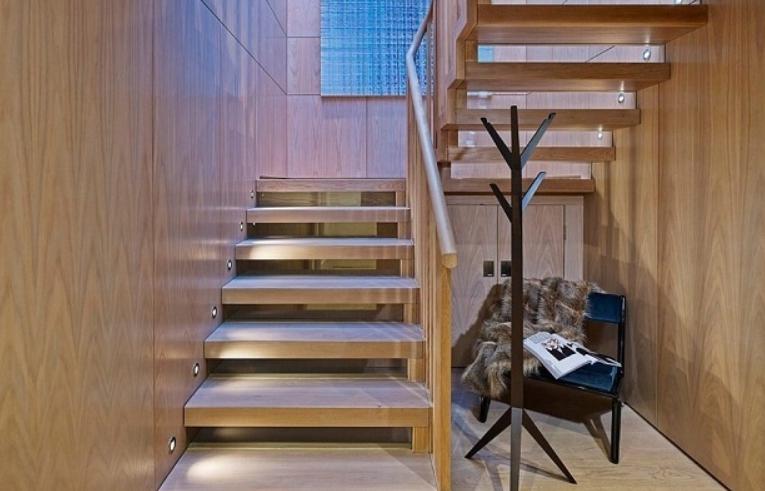
Why do you need stair lighting?
Staircase lighting should be designed separately, as it differs from conventional options due to such features:
- The main purpose of lighting - the safety of people when moving on the staircase. It is important for a person to move quietly without the risk of stumbling, falling, etc. Therefore, the light should well highlight at least the steps, so that even people with poor eyesight can see where to step.
- The second function is decorative. Lighting can be used to make a staircase design element of the interior design, which attracts attention. With the help of lighting you can accentuate the features of the staircase and give it a more modern look.Due to the beautiful lighting design looks much more attractive in the dark.
- Light does not have to run constantly (the exception is decorative LED lighting, which consumes little electricity). Therefore, it is worth think in advance of its system of switching on and offto make the process convenient. Now there are many options that allow you to not put standard switches.
- If the lights are in the access area of a person or pets, they should not be very hot, in order to eliminate the risk of burns. There are high requirements for fire safety. It is better to use lamps that are minimally heated and even in case of failure do not overheat.
You can use both special lamps for stairs and any others, if they are better suited.
How to arrange stairway lighting
Before you arrange stairway lighting in the house, you need to consider a number of recommendations that will allow you to get a safe system and avoid common mistakes:
- Choose economical lampsAs the lighting works frequently, and if it consumes a lot of electricity, the costs will increase. It is best to calculate the total consumption to understand how much electricity is needed for the system to work properly.
- The configuration of the staircases and the total length of the structure is taken into account. The longer the staircase - the higher the requirements for its lighting and the more lighting fixtures will need to be installed. When planning the location of the equipment to remember that the minimum standard of illumination is 20 lux, from this figure and it is worthwhile to start from.
- The light flux should be distributed evenly to avoid glare and discomfort to the eyes anywhere in the staircase. Therefore give preference to lamps with soft, diffused light, comfortable for the eyes and at the same time effectively illuminate the space.
- It is necessary to think in advance about the power system of lighting fixtures, as in case of power outages it can be difficult to go downstairs. Often set self-contained equipment that runs on 12 V, and in case of power failure passes to the battery, which is put nearby, so that lighting worked at least an hour, even without electricity.
- Lighting elements must clearly transmit the outlines of objects and not distort their contours, as it affects safety. It is worth thinking in advance how the light will be distributed and whether there will be areas that will not be well lit.

When determining light temperature it is better to choose options that do not distort the colors of objects.
Types of lighting
Step illumination can be implemented in different ways. The location of the light source differs, so it is easiest to classify options on this basis. Different types of equipment can be used.
Top

The light comes from above, as usual, and illuminates the entire flight of stairs. The system is simple and does not require alterations in the room, but is more suitable for single span structures that can normally be illuminated by a common chandelier. If the staircase is a complex shape or spiral, to provide normal lighting with one source will not work.
The second option - spotlights or track systems. They can be installed in any suitable location as on the ceiling, and at the bottom of the upper deck, if there are several of them. By adjusting, you can direct the light flux where you need it, or move the spotlights if there is a track rail.
Side overhead
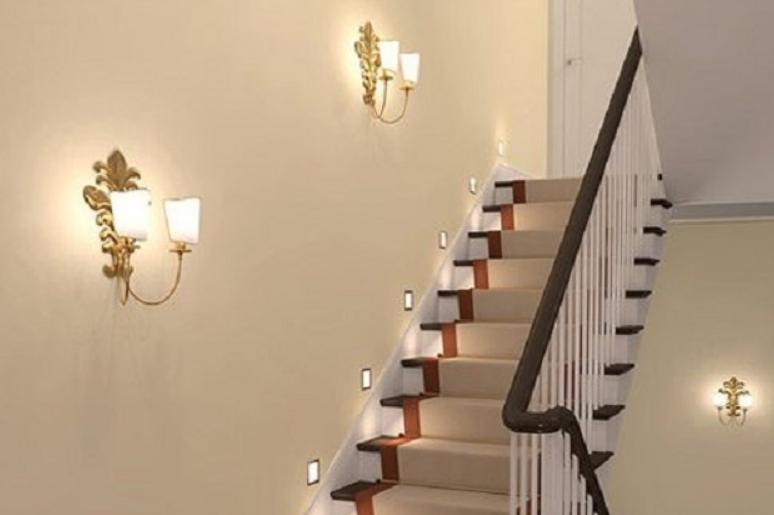
Fixtures are mounted on the wall above the average height of the person, so as not to cling to the equipment head. Different models can be used - from classic sconces to modern with a stream of directional light, it all depends on the design of the stairs.
You can use overhead or partially recessed options, they are suitable for constructions of small width, where you do not need a lot of light. Often use wall systems with diffused plafonds or reflected light, softly flooding the space. The main thing is that the steps should be illuminated evenly., without shadows and poorly lit areas.
Side lighting
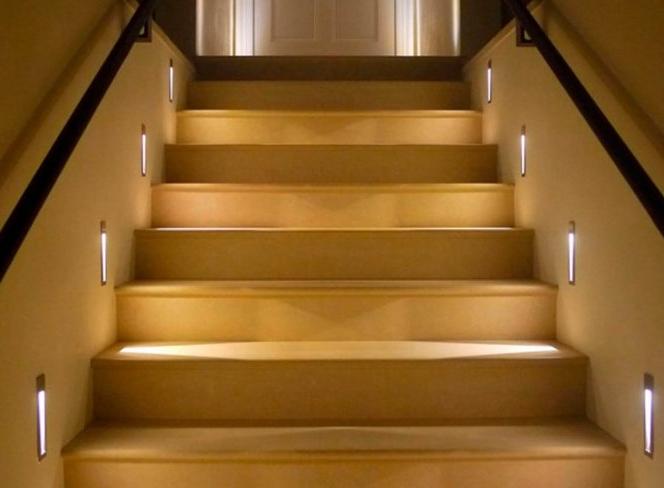
This option differs from the previous one in the fact that the lighting is built into the wall at a height of no more than 25 cm from the surface above each step or every other step. Using directional light fixtures can provide good illumination of the space.
But if there are children or elderly people in the family, there may be problems with orientation in space when going downstairs. It is best to supplement the side recessed lighting with general lighting to eliminate problems and ensure good visibility.
Step illumination

This method is suitable for different designs and can be implemented with different equipment. In the past, the process was complicated due to the fact that it was necessary to cut the lights and lead the wiring from the inside. It required a lot of space and safety during installation.
It is much easier to use LED strip, with its help you can provide a good quality of light. The element is glued to the ledges of the steps with a width of only 2 cm. It is not difficult to connect, any person who has at least the skill of soldering wires can cope with the work.
LED strip works with a voltage of 12 V, so the light is safe.
Backlighting for railings
Another solution that allows you to well illuminate the staircase. The most common use of LED strip, which is glued to the back or bottom of the railing and illuminates the steps along its entire length. In this connection and installation will not cause any special difficulties, you do not have to redo anything, even if the staircase is already assembled.
Option is not suitable in cases where the railing is small and their length is not enough for normal lighting the entire span. It is not very good for constructions of great width, where the light from under the railing will not be enough for normal lighting of the span. It can be combined with other types of lighting.
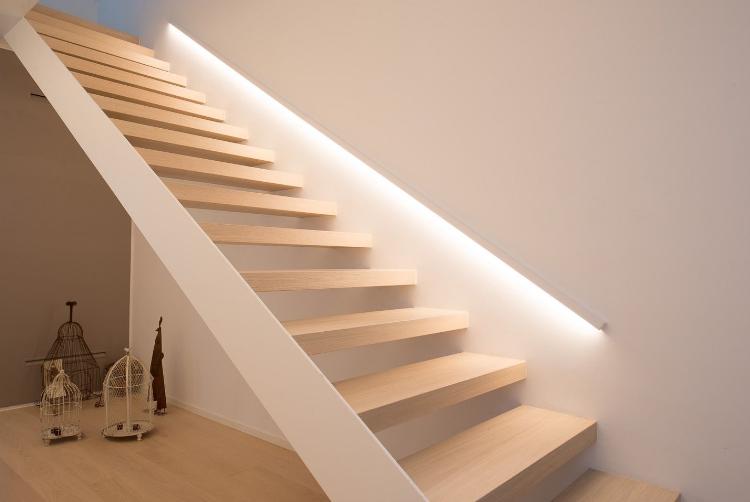
Window sill lighting
Suitable only for staircases with one or more windows. To emphasize the openings and at the same time to improve the lighting of the staircase, at the bottom of the window sill mount LED strip lighting. Here it is difficult to achieve uniform lighting, as it all depends on the location and size of the window openings.
This option is used for decorative purposes, but it can improve lighting, if used step lighting, which can not give the desired effect. When installing it is worth selecting the position so as to avoid accidental damage to the LED strip.
Lighting schemes for different types of stairs
Depending on the design of the staircase and the material of its manufacture, different lighting options can be used. It is better to understand this aspect in advance to immediately select those solutions that are suitable.
First, you should determine the type of staircase, there are three basic options:
- Spiral take up minimal space, look original, but require high-quality installation and good lighting. When using step lighting, you need to illuminate each element. The best option is either built-in options, or LED strip. You can use general lighting from the ceiling or walls, if you do not want to deal with the lighting of the steps.
- Marching consist of one or more flights, which can be both straight and complex shapes. Here you can use any solutions, it all depends on the design and angle of inclination - the more it is, the higher the requirements for lighting for safety. Schemes should be chosen individually, based on the features of the house or cottage and the available lighting.
- Floating steps - a new word in stair constructions, they are mounted on special brackets and seem to hang in the air. For this option is worth using high-quality lighting of local or general type. But it is better to combine the different options for safety.Soaring structures are original and require quality lighting.
It also matters the material from which the staircase is made. This determines the peculiarities of installation and the possibility of attachment to a particular surface. It is worth considering these recommendations:
- Wooden stairs are used most often because of the availability and convenience of processing the material. In this case, the wiring should be packed in non-combustible corrugation, which is attached in any suitable place. It is not difficult to mount lights or mortise recessed variants, as there are rigging and fasteners of any type. It is better to choose equipment that does not warm up in the process.Wood is the traditional material for making stairs.
- Metal structures are strong and durable, but it is difficult to attach fixtures or wiring to them. LED tape is most often used, as it simply glues to the metal and holds up well. In this case, lighting from the walls or ceiling is often used, as it does not require any special preparation.
- For acrylic and glass elements it is most important to provide diffused light, so often use special screens or place an LED strip in the ends. Since the material is transparent, it is very important to lay the wiring carefully, and the lighting can be put even under the stairs, it will give normal light, as most of the structure passes it without problems.
- Concrete options are strong and easy to implement, but it is difficult to mount lights on them, and laying the wiring will not work. In this case, most often the design is lined with wood or other material, and lighting equipment is placed on the walls or ceiling, so it is easiest and most convenient.
There can also be different combinations of materials, there are no restrictions, the main thing is the reliability and safety of the design.
How to make your own stair illumination
Let's find out how to make your own staircase illumination leading to the upper floor. The work is not difficult and depends on the type of equipment used. You can highlight two main options and consider each separately.
Built-in lights
This type was the most commonly used a few years ago. Now it is used less frequently, but in some situations it will do just fine. When carrying out the work, follow a few tips:
- To begin with, determine the place of installation of fixtures, their position and the number. It is worth proceeding from the power of the equipment, the required level of illumination and the peculiarities of the design. You can embed the housing in the steps or put them in the wall, if it is made of plasterboard.Built-in versions are most convenient to put in plasterboard walls.
- When using side lighting, you should lay the wiring already at the stage of installation of drywall sheets, this will greatly simplify the work later. It is also better to buy in advance drill bits for gypsum plasterboard according to the size of the bodies of the fixtures. Marking the location of the equipment is done in advance, so that the holes were symmetrical, at the same distance, and everything looked perfect.Wood or plasterboard crowns will also work for plastic.
- It is best to connect the lights with pads, you should not do twisting, as this does not provide the necessary reliability and durability. Leave the wire with a margin, it should not be stretched or kinked.
- If the lights will be built into the treads or steps, the holes are made with a special drill bit for wood. And the work can be done even before the installation of the stairs, on the removed elements it is much easier.
- When laying wiring under the steps, place it in corrugations or lead it out of the wall, if possible. Pay attention to safety, protect the contacts reliably to avoid electrocution of people and pets.Corrugated hose is best for wiring.
- Choose fixtures with impact-resistant plafonds, as they can be damaged by feet.
It is better to choose fluorescent or LED options, as they do not heat as much as halogen or incandescent bulbs. In addition, the power consumption of the former is much lower.
LED Strip
The easiest and safest solution that can be installed without any electrical experience. If you choose a quality strip, it will illuminate a space of any size and configuration well. The work is carried out as follows:
- The tape is selected with the appropriate brightness ratings. They depend on the number of LEDs per linear meter, which can vary from 30 to 120 pieces. It is possible to choose the light temperature, which is also important. Most often use options that are close to natural light, which transmit the colors correctly.
- The tape is easiest to glue on the bottom of the steps or any other elements, it can be projections on the walls, railings, window sills, etc. It is worthwhile to measure the length in advance and choose the size of the tape in accordance with the cut lines, they are located at the same distance. Cut With scissors with sharp blades.Install the LED strip can be on the back side under the ledge.
- Wires can be connected with connectors or by soldering and cover the attachment point with heat shrink tubing. Use a cable with copper conductors in flexible insulation.
- Determine the location of the power supply in advance. It is better to hide it, but it is important not to place the assembly in a confined space, as it must be cooled during operation.
- The surface should be cleaned and degreased before taping. If the substrate is highly absorbent, it is best to reinforce it with a penetrating primer. If the adhesive layer is weak, you should additionally use double-sided adhesive tape, which is cut into narrow strips.
If battery power is used, find a place to place it beforehand.
Staircase illumination on the steps with a motion sensor
If you do not want to put standard switches for staircase lighting, you can make a staircase light with a motion sensor. Then it will turn on only when necessary, which will save energy. You can use one of the following options:
- Install sensors at the top and bottom that react to motion in a certain segment and turn on the light. The most important thing is to choose a good place for their placement, so that the lighting starts at the right moment. Most often the equipment is placed on the approach, so that when a person sets foot on a flight of stairs, the light is already working.Sensors need to be installed correctly so that they are triggered at the right moment.
- Acoustic sensors that respond to a clap or the sound of a voice can be used. They are located in places specified in the installation instructions, there may be several options, it is better to follow the manufacturer's recommendations.
- Another option - a load sensor, it is attached to the first steps, so that the light turns on when a person stepped on the surface.
It is not uncommon to combine two variants of automatic switching, to ensure good efficiency and prevent malfunctions.
When installing, follow the instructions in the manual and observe connection diagram. Usually the system is not much different from the options with a normal switch, the main thing is to position the sensors correctly so that they are triggered in time.
Read also: How to adjust the motion sensor for lighting
In conclusion, we suggest to see: 3 ways to turn on the light on the stairs.
A step-by-step video tutorial on how to install lighting on a concrete staircase clad in wood.
Provide staircase lighting in a private home or duplex apartment is very important, since the safety and convenience of movement depends on it. When choosing should give preference to safe options with low power consumption, it is better to use what you can install yourself.

